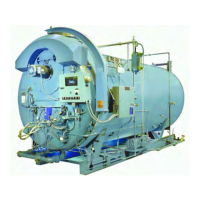Chapter 8 — Inspection and Maintenance
Part No. 750-184 8-7
F. FLAME SAFETY CONTROL
The microprocessor based control requires minimal maintenance because
the safety and logic timings are inaccessible. There also are not any
accessible contacts. Check to see that the retaining screw is securely holding
the chassis to the mounting base. Also check to see that the amplifier and
the program module are tightly inserted.
The relay's self-diagnostic ability includes advising when it or its plug-in
modules are at fault and require replacement.
Your spare control should be stored in a dry atmosphere and wrapped in
plastic. During an extended shutdown (e.g., seasonal), the active control
should be removed and stored. Moisture can cause problems with control
operation.
It is recommended that service be rotated between the active and a spare
control to assure a working replacement is available.
When replacing a control, be sure to lock out the main
power supply switch since the control is “hot” even though
the burner switch is off. Failure to follow these instructions
could result in serious personal injury or death.
Be sure the connecting contacts on the control and its base are not bent out
of position.
The flame detector lens should be cleaned as often as operating conditions
demand. Use a soft cloth moistened with detergent to clean the lens.
A safety check procedure should be established to test the complete
safeguard system at least once a month, or more often. Tests should verify
safety shutdown and a safety lockout upon failure to ignite the pilot, upon
failure to ignite the main flame, and upon loss of flame. Each of the
conditions should be checked on a scheduled basis.
The following tests should be used to test the complete safeguard system. If
the sequence of events is not as described, then a problem may exist.
Contact your local Cleaver-Brooks authorized representative for assistance.
Checking Pilot Flame Failure
Close the gas pilot shutoff cock. Also shut off the main fuel supply. Turn the
burner switch “on.”
The pilot ignition circuit will be energized at the end of the pre-purge period.
There should be an ignition spark, but no flame. Since there is no flame to
be detected, the program relay will signal the condition. The ignition circuit
will deenergize and the control will lock out on a safety shutdown. The flame
failure light (and optional alarm) will be activated. The blower motor will run
through the post-purge and stop.
Turn the burner switch off. Reset the safety switch. Reopen the gas pilot
shutoff cock and re-establish main fuel supply.
Checking Failure to Light Main Flame
Leave the gas pilot shutoff cock open. Shut off the main burner fuel supply.
Turn the burner switch on. The pilot will light upon completion of the pre-

